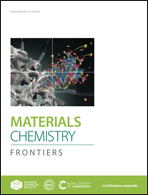Realizing luminescent and dielectric abilities via lattice-disturbance with Eu3+/Ti4+ co-substitutions in Ba2NaNb5O15 ceramics†
Abstract
Tungsten bronze-type ceramics have been widely investigated as one of the best ferroelectric frameworks. RE-doped Ba2NaNb5O15 phosphors have been reported with unsatisfactory luminescence efficiencies. It is attractive to develop a ferroelectric showing multifunctionality with electric and luminescence performances. In this work, the cation substitutions of (Eu3+ → Ba2+) and (Ti4+ → Nb5+) are realized in tungsten bronze-type Ba2NaNb5O15 to develop optoelectronic ceramics (luminescence + dielectric). The introduction of framework-disturbances is regarded to be an effective strategy on modification of the luminescence and electronic properties. The ceramics were prepared using the high-temperature solid-state reaction. The cation disorder due to Eu3+/Ti4+ co-doping can significantly enhance the luminescence efficiency and thermal stability. Meanwhile, Eu3+/Ti4+ co-doping has a strong influence on the microwave dielectric performances, that is, the dielectric constant (εr) values and quality factor (Q × f) were significantly improved. The temperature coefficient of resonant frequency (τf) is optimized. The improvement of optoelectronic effects shows a significant dependence on cation disorder of the ferroelectric framework.



 Please wait while we load your content...
Please wait while we load your content...